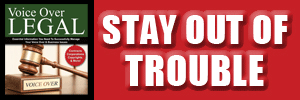Copyrights: Reel 'EmIn To Your Demos
By Robert J. Sciglimpaglia Jr., Esq.
A common misconception of U.S. copyright law is that a work does not become copyright protected until it is filed with the U.S. Copyright Office. Actually, copyright protection begins
immediately when the work is created in a fixed form.
Some people understand this fact and try to protect their work with a “poor man’s copyright” - where they mail their material to themselves and keep the envelope sealed so that the postmark can act as a “registration.”
So why spend $30 to register the work with the U.S. Copyright Office?
The answer to this question is that for a mere $30, your work will be registered publicly and, more importantly, you cannot file a lawsuit with any court if someone infringes your work unless and until you have filed for registration.
There is no such thing as a “poor man’s copyright.”
Another important benefit of the Copyright Act is that you do not have to prove actual damages in order to recover.
If you prove an unlawful infringement, or commercial use, of your work under the Act, you can be awarded statutory damages by a judge in an amount ranging from $750 to $30,000. And if the Court finds that infringement to be willful, the Court may increase the award up to $150,000!
Not a bad return on your $30 “investment.”
That said, be extremely cautious when creating demo reels to avoid using copyrighted works - such as songs - without the permission of the author. In such a case, distributing a demo reel with the intent of getting work would constitute an actionable infringement under the Act. (See:
Copyrights: Will Your Demo Get You Sued?)
HOW TO COPYRIGHT
Assuming your demo reel is an original creation, how do you copyright it?
You simply submit Form SR, along with the $30 fee and a non-returnable copy of your work on a tape or compact disc. Mail the material to:
Library of Congress
Copyright Office
101 Independence Ave, S.E.
Washington, DC 20559-6000.
The copyright is effective on receipt by the Copyright Office, and you will receive your registration certificate in four to five months. Because of this time delay, it’s advisable to send the material by either:
Overnight courier material should be delivered to:
Congressional Courier Acceptance Site (CCAS)
2nd and D Streets, N.E.
Washington, DC.
Also note that new security measures for copyright submissions require that all mail be screened off-site. This adds three to five days to the delivery time to the Copyright Office.
To minimize delays, send your demo in a box, rather than envelope. Also, use standard full-sized jewel boxes rather than slim line cases, since the larger cases are more likely to survive the mail radiation process.
THE COPYRIGHT NOTICE
When you learn that the Copyright Office has received your material, you should place a copyright notice on your work. This informs everyone that your work is protected.
Even though a copyright notice is not required, it’s a good idea because the absence of a notice may give someone who infringes on your work an
“innocent infringement” defense.
An “innocent infringement” defense is where the infringer claims he or she did not realize the work was protected. And this can mitigate the statutory damage award under the Act.
The form of a copyright notice should be: © YEAR John Doe.
The year indicates the date of creation or publication - not the date the copyright was registered. The name is the name of the author.
Now good luck reeling in those copyrights! For more information, visit the Copyright Office web site:
www.copyright.gov
Robert J. Sciglimpaglia Jr. is an attorney with the firm of Kerin & Canty, 193 East Avenue, Norwalk, CT. He is also a voice-over artist, on-camera actor, and voice-over teacher with Such A Voice and John Robert Powers.
Email:
robscig@usa.net
Web:
www.robertpaglia.com
Internet Movie Database:
http://imdb.com/name/nm2215197
|
Get your bi-weekly dose here ... all things VO!
For essential voice-over business strategies
Email alerts to new VoiceOverXtra articles
With Sean Daeley and Paul Stefano - check it out!
As of the NEW website launch, 03/22/2012

 If you have a voice-over reel that is a totally original work, do you really need to file a copyright for it?
If you have a voice-over reel that is a totally original work, do you really need to file a copyright for it?








In order to protect your character voice you need to make sure your contract clearly spells out that you own the voice and that whoever is producing is licensing your voice for that character. Who owns the rights to the voice would be spelled out by contract prior to the job commencing. If there is no contract then unless you were an employee of the company you voiced for the voice would be your property.
Rob Sciglimpaglia